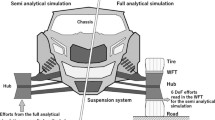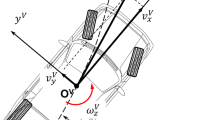Abstract
Nonlinear governing equations used to analyze the handling of a ground vehicle are derived from the Lagrange equations of motion. The derived equations are coded using VBA (Visual Basic for Applications) embedded in Microsoft’s Excel Software and simulated in the time domain using the 4th-order Runge-Kutta method. A total of six degrees of freedom are used in the equations; three of these are the directional translation, lateral translation, and yaw of a platform (unsprung) on the base of an inertial ground coordinate, and the other three are the roll, pitch, and yaw of a body (sprung) by a platform-fixed coordinate. Four driving torques and four wheel angles of all tires are used as input control parameters. A simplified Calspan tire model is adopted for the generalized forces of the equations. This is a combined model that can be used to obtain tractional (or braking) and side forces using the inputs of the directional and side-slip ratios and the vertical force. The VBA code realized in this study is validated by comparisons with trimmed equilibrium results and the test data cited in published papers. The major characteristics of this study are: (1) the coordinate systems of the equations are mixed with the inertial frame and the platform-fixed frame, and, as a result, almost all types of driving conditions with long mileages can be simulated; (2) vertical movement is eliminated due the focus on the handling analysis; (3) the body-yaw degree of freedom is separated from the platform-yaw degree of freedom; and (4) the programming is performed by VBA, which is rarely used in the vehicle dynamics field.
Similar content being viewed by others
Abbreviations
- Subscript ij :
-
FL(Front Left), FR(Front Right), RR(Rear Right), RL(Rear Left)
- SCTM :
-
simplified calspan tire model
- VBA :
-
visual basic for applications
- c.g. :
-
center of gravity
- X, Y, Z :
-
displ. components of inertial coordinate
- \(\dot X,\dot Y\) :
-
velocity components of inertial coordinate
- x p , y p , z p :
-
displ. components of platform-fixed coord
- x 1 , y 1 , z 1 :
-
displ. components of body-fixed coordinate, whose origin is ball joint of platform mass
- x 2 , y 2 , z 2 :
-
displ. components of body-fixed coordinate, whose origin is the c.g. point of body
- x t , y t , z t :
-
displ. components of each tire coordinate
- g :
-
acceleration due to gravity
- m T , m U , m S :
-
total, platform (unsprung) and body (sprung) masses
- I 2xx , I 2yy , I 2zz :
-
moments of inertia of body (sprung) about body-fixed coordinate (x 2 , y 2 , z 2 )
- I 2xy , I 2yz , I 2zx :
-
products of inertia of body (sprung) about body-fixed coordinate (x 2 , y 2 , z 2 )
- [T kl ] mn :
-
elements of coord. transformation matrices
- \(\alpha ,\dot \alpha ,\ddot \alpha \) :
-
yaw angle, rate, acceleration of platformfixed coord. (x p , y p , z p ) based on Z of inertial coord.
- \(\beta ,\dot \beta ,\ddot \beta \) :
-
yaw angle, rate, acceleration of body-fixed coord. (x 1 , y 1 , z 1 ) based on z p of platform coord.
- \(\varphi ,\dot \varphi ,\ddot \varphi \) :
-
roll angle, rate, acceleration of body-fixed coord. (x 1 , y 1 , z 1 ) based on x p of platform coord.
- \(\theta ,\dot \theta ,\ddot \theta \) :
-
pitch angle, rate, acceleration of body-fixed coord. (x 1 , y 1 , z 1 ) based on y p of platform coord.
- δ ij :
-
ij’s tire wheel angle (ij=FL, FR, RR, RL)
- Ω ij :
-
rolling angular velocity of ij’s tire wheel
- R e :
-
tire effective radius
- h cg , h L , h U :
-
distances from ground to vehicle mass center, from platform mass to ground, and from platform mass to body mass
- b F , b FL , b FR :
-
distance from body mass to front axle
- b R , b RR , b RL :
-
distance from body mass to rear axle
- t F , t R :
-
wheel tracks of front and rear axle (t FL = t FR =0.5t F , t RR =t RL =0.5t R )
- K ij :
-
ij’s suspension spring coefficient (K FL=K FR = K F , K RR =K RL =K R )
- K β :
-
angular spring coefficient of body yaw
- C ij :
-
ij’s suspension damping rate
- C β :
-
angular damping rate of body yaw
- K SR :
-
ratio of steering wheel and tire wheel
- F tx_ij , F ty_ij , F tz_ij :
-
ij’s tire force of x-, y-, and z-direction based on each tire coordinate (x t , y t , z t )
- C 1 , C 2 , C 3 , C 4 , K a , F ZT , A 0 , A 1 , A 2 , CS/FZ, K µ :
-
coefficients of SCTM
- a p0_ij :
-
tire contact patch (when F tx_ij =0) in SCTM
- a p_ij :
-
tire contact patch (when F tx_ij ≠0) in SCTM
- T w , T p :
-
tire tread width and tire pressure in SCTM
- K s_ij :
-
lateral stiffness coefficient in SCTM
- K c_ij :
-
longitudinal stiffness coefficient in SCTM
- µ 0 :
-
nominal friction ratio in SCTM
References
Abe, M. (1994). Vehicle Dynamics and Control. Sankaidou (in Japanese). Tokyo.
Ahmad, F. B., Hudha, K. and Harun, M. H. B. (2009). Pneumatically actuated active suspension system for reducing vehicle dive and squat. J. Mekanikal, 28, 85–114.
Allen, R. W., Szostak, H. T., Rosenthal, T. J. and Johnston, D. E. (1986). Test methods and computer modeling for the analysis of ground vehicle handling. SAE Paper No. 861115.
Bergman, W. (1965). The basic nature of vehicle understeer-oversteer. SAE Paper No. 650085.
Buffalo (2003). Tire model in driving simulator. http://code.eng.buffalo.edu/dat/sites/tire/tire.html.
Cameron, J. T. and Brennan, S. (2005). A comparative, experimental study of model suitability to describe vehicle rollover dynamics for control design. IMECE2005-80508, Orlando, 1-10.
D’souza, A. F. and Garg, V. K. (1984). Advanced Dynamics-Modeling and Analysis. Prentice-Hall, Inc., Englewood Cliffs. New Jersey. 141–145, 203–228.
Gruening, J., Williams, K. A., Hoffmeister, K. and Bernard, J. E. (1996). Tire force and moment processor. SAE Paper No. 960182, SAE SP-1141, 85–90.
Ko, Y. E. and Song, C. K. (2010). Vehicle modeling with nonlinear tires for vehicle stability analysis. Int. J. Automotive Technology 11,3, 339–344.
Lee, A. Y. (1998). Coordinated Control of Active Devices to Alter Vehicle Rollover Tendencies. http://trsnew.jpl.nasa.gov/dspace/bitstream/2014/20382/1/98-1327.pdf. 1–13.
Rosenberg, R. M. (1980). Analytical Dynamics of Discrete Systems. 2nd Edn. Plenum Press. New York. 265–268.
Author information
Authors and Affiliations
Corresponding author
Rights and permissions
About this article
Cite this article
Yang, S.M., Kim, J.H. Derivation and validation of nonlinear governing equations for an analysis of vehicle handling. Int.J Automot. Technol. 12, 561–570 (2011). https://doi.org/10.1007/s12239-011-0066-0
Received:
Revised:
Published:
Issue Date:
DOI: https://doi.org/10.1007/s12239-011-0066-0




